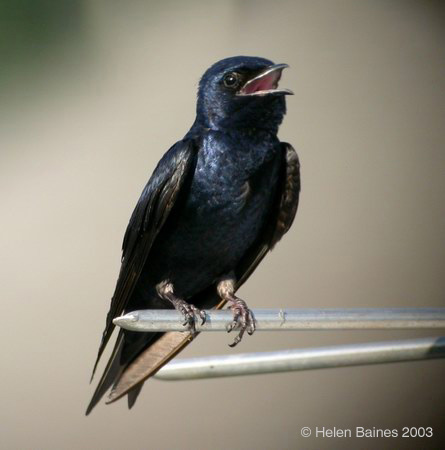m |
(→External Links: improved GSearch; GS checked 1) |
||
| (16 intermediate revisions by 9 users not shown) | |||
| Line 1: | Line 1: | ||
| − | + | [[Image:Purple_Martin.jpg|thumb|550px|right|Male<br />Photo © by {{user|HelenB|HelenB}} <br/>Houston, [[Texas]], [[USA]]]] | |
| − | [[Image:Purple_Martin.jpg|thumb| | + | ;[[:Category:Progne|Progne]] subis |
| − | |||
| − | </ | ||
| − | |||
| − | |||
| − | |||
| − | |||
| − | == | + | ==Identification== |
| − | + | 7-8 1/2" (18-22 cm).<br /> | |
| − | + | The adult male is a dark steel-blue. <br /> | |
| + | Females and Juveniles are duller, with grey underparts. It takes 2 years for these birds to attain full adult breeding plumage. This can make it difficult to identify the birds. | ||
| + | ====Flight==== | ||
| + | [[Image:Purple Martin Progne subis subis male McAllen Nature Center.jpg|thumb|350px|right|First Summer male<br />Photo © by {{user|Stanley+Jones|Stanley Jones}}<br />McAllen Nature Center, McAllen, Hidalgo County, [[Texas]], [[USA]], April 2017 ]] | ||
| + | Overhead is similar in shape to the [[European Starling]], but flight more buoyant and gliding. | ||
| + | ==Distribution== | ||
| + | Breeds from [[British Columbia]], central interior [[Canada]], and [[Nova Scotia]], south to [[Mexico]], but absent from interior western mountains and Great Basin.. | ||
| − | + | Winters in tropics. Migrates south to [[Brazil]]. Common in the state of São Paulo. | |
| − | |||
| − | |||
| − | == | + | Accidental vagrant to the [[UK]] and to [[Argentina]]. |
| − | + | ==Taxonomy== | |
| − | + | ====Subspecies==== | |
| + | [[Image:Purple Martin 2016-30.jpg|thumb|350px|right|Likely a female<br />Photo © by {{user|Hughv|Hughv}}<br />College Park, [[Maryland]], May 2016]] | ||
| + | This is a [[Dictionary_M-S#P|polytypic]] species<sup>[[#References|[1]]]</sup> consisting of three subspecies<sup>[[#References|[1]]]</sup>: | ||
| + | *''P. s. subis'' - much of eastern 3/4 [[North America]] from [[Canada]] to [[Mexico]], winters in Amazonian [[Brazil]] | ||
| + | *''P. s. arboricola'' - western North America, winters in Atlantic South East Brazil | ||
| + | *''P. s. hesperia'' - [[Arizona]] and western Mexico, winters in [[South America]] | ||
| + | ==Habitat== | ||
| + | Forest edges, open woodlands, residential areas, and agricultural land. Often near water. | ||
| − | == | + | ==Behaviour== |
| − | + | ====Diet==== | |
| − | + | Their diet consists almost entirely of air-borne insects, particularly ants, wasps and bees. | |
| + | ====Breeding==== | ||
| + | Their nest is made of grass and plant material. In most of their range they will nest exclusively in man-made nest boxes, though some birds will use tree cavities west of the Rocky Mountains. The clutch consists of 4-5 white eggs. | ||
| − | == | + | ====Vocalisation==== |
| − | + | The call is ''tchew-wew'', or ''pew pew''. | |
| − | == | + | ==References== |
| − | + | #{{Ref-Clements6thAug17}}#Handbook of the Birds of the World Alive (retrieved August 2017) | |
| + | #Wikipedia | ||
| + | {{ref}} | ||
==External Links== | ==External Links== | ||
| − | + | {{GSearch|"Progne subis" {{!}} "Purple Martin"}} | |
| − | [[Category:Birds]] | + | {{GS-checked}}1 |
| + | <br /> | ||
| + | <br /> | ||
| + | |||
| + | [[Category:Birds]] [[Category:Progne]] | ||
Latest revision as of 15:40, 9 June 2023
- Progne subis
Identification
7-8 1/2" (18-22 cm).
The adult male is a dark steel-blue.
Females and Juveniles are duller, with grey underparts. It takes 2 years for these birds to attain full adult breeding plumage. This can make it difficult to identify the birds.
Flight

Photo © by Stanley Jones
McAllen Nature Center, McAllen, Hidalgo County, Texas, USA, April 2017
Overhead is similar in shape to the European Starling, but flight more buoyant and gliding.
Distribution
Breeds from British Columbia, central interior Canada, and Nova Scotia, south to Mexico, but absent from interior western mountains and Great Basin..
Winters in tropics. Migrates south to Brazil. Common in the state of São Paulo.
Accidental vagrant to the UK and to Argentina.
Taxonomy
Subspecies
This is a polytypic species[1] consisting of three subspecies[1]:
- P. s. subis - much of eastern 3/4 North America from Canada to Mexico, winters in Amazonian Brazil
- P. s. arboricola - western North America, winters in Atlantic South East Brazil
- P. s. hesperia - Arizona and western Mexico, winters in South America
Habitat
Forest edges, open woodlands, residential areas, and agricultural land. Often near water.
Behaviour
Diet
Their diet consists almost entirely of air-borne insects, particularly ants, wasps and bees.
Breeding
Their nest is made of grass and plant material. In most of their range they will nest exclusively in man-made nest boxes, though some birds will use tree cavities west of the Rocky Mountains. The clutch consists of 4-5 white eggs.
Vocalisation
The call is tchew-wew, or pew pew.
References
- Clements, J. F., T. S. Schulenberg, M. J. Iliff, D. Roberson, T. A. Fredericks, B. L. Sullivan, and C. L. Wood. 2017. The eBird/Clements checklist of birds of the world: v2017, with updates to August 2017. Downloaded from http://www.birds.cornell.edu/clementschecklist/download/
- Handbook of the Birds of the World Alive (retrieved August 2017)
- Wikipedia
Recommended Citation
- BirdForum Opus contributors. (2024) Purple Martin. In: BirdForum, the forum for wild birds and birding. Retrieved 12 May 2024 from https://www.birdforum.net/opus/Purple_Martin
External Links
GSearch checked for 2020 platform.1





